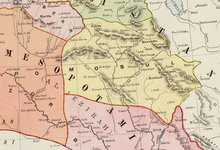|
Naft KhanaNaft Khana is an Iraqi town in Diyala Governorate, central Iraq, near the Iraqi-Iranian border.[1] Its population were Kurdish nationality during the Iran-Iraq war. Its residents were displaced according to the Arabization policy. Nearby are oil fields containing oil wells found by British companies after the British occupation in 1924.[2] It is considered one of the richest areas in the Diyala Governorate.[3] Iraq-Iran warAnd it turned into a purely military area, where Iraqi army established camps and headquarters for the border guards, and after the American-Iraqi war, and after the fall of Saddam Hussein's regime, specifically in the year 2003, Kurdish families began to return to this area, but they found it a barren desert inhabited only by wolves.[4][5] Oil field Approximate location as per a 1948 World Oil map: 34°00′43″N 45°26′28″E / 34.01193°N 45.44113°E[6] The territory belonging to present-day Iraq was part of Transferred Territory, land that was given by Persia to the Ottoman Empire (Treaty of Constantinople of November 17, 1913) and then became part of the Kingdom of Iraq. The Anglo-Persian Oil Company had acquired rights over the area with the 1901 d'Arcy concession and those rights were safeguarded under the land transfer.[7] The field was "discovered" in 1918 by George Whitfield Halse (1885-1968), who on the request of the British Army prospected for sources of oil closer to the frontline (than Abadan). He left the area in 1918 or 1919, but based on his conclusions, in 1923 oil was struck and Naft Khaneh became the second oil field discovered in the Middle East.[8] The Iraqi part of the field was transferred to the Khanaqin Oil Company (subsidiary of APOC) in 1925, named after the nearby Iraqi town where a small topping plant was also set up,[7] and put into operation on May 7, 1927.[9] In the 1920s a 24-mile 4-inch line was laid to connect the field to the refinery.[10] The Kermanshah Petroleum Oil Company (also subsidiary of APOC) was formed in 1934 to develop the Iranian side (called Naft-i-Shah). In 1934 a 158-mile 3-inch pipeline to Kermanshah was completed over difficult terrain. It had 4 pumping stations, three powered by 3 x 45bhp diesel engines (9 total) and one by steam with high pressure horizontal reciprocating pumps in each.[7] A 3000 bbl/day topping plant was built in Kermanshah.[11] Production was concentrated on the Iraqi side of the border. by years end 1947, the cumulative production of the entire field was 36 million barrels, of which 27 million had come from Naft Khaneh wells.[12] While the new government of Iraq had affirmed the concession in 1926, it forced a renegotiation in 1951 and gave the Anglo-Iranian Oil Company (new name given to the APOC) 7 years to increase production to 40,000bpd or lose the right. The two-well field only reached 12,000 and so on November 30, 1958 the government took full ownership of the field from AIOC, now renamed BP. At that time the average production had fallen back to 4,450bpd.[13]
References
|